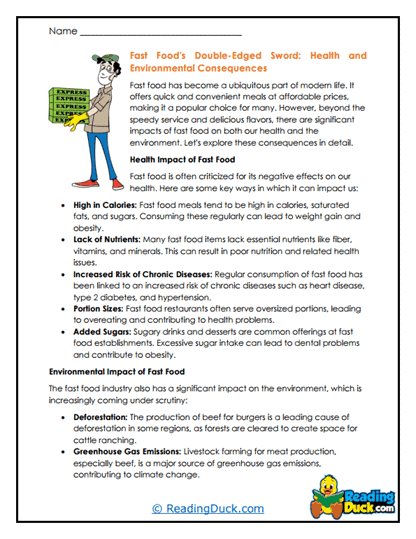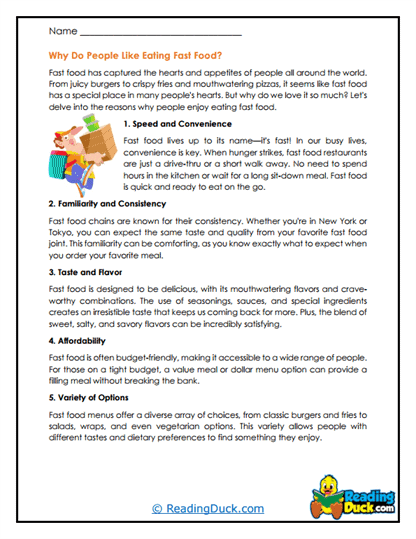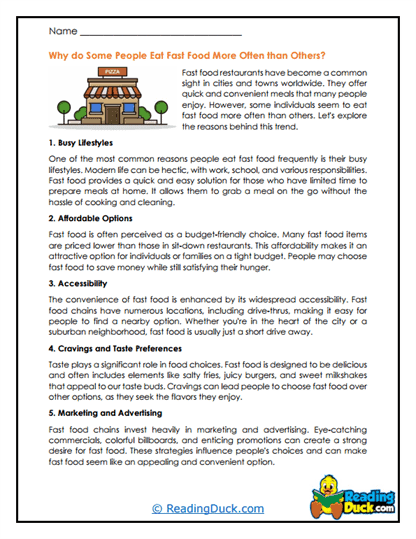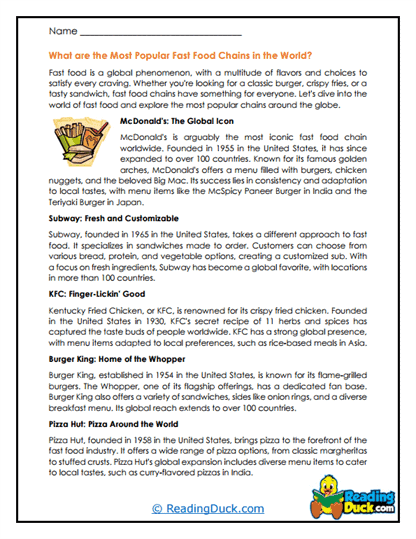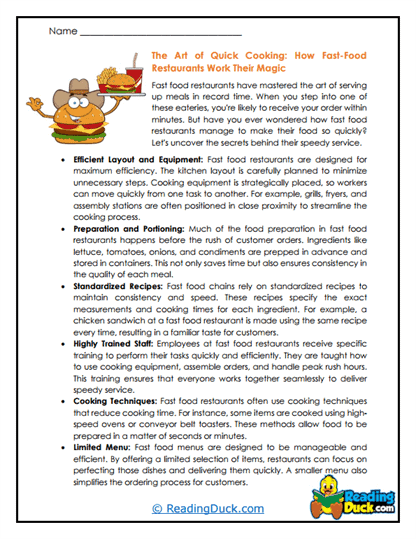Fast Food Worksheets
About Our Fast Food Worksheets
Our Fast Food Worksheets offer students an engaging and comprehensive exploration of the fast food industry, its history, cultural impact, and the various social and health-related issues it raises. These worksheets fall under the "Culture" category because fast food is a significant aspect of modern culture, shaping everything from eating habits to business models and even popular media. The worksheets are designed to provide students with a deep understanding of fast food as a cultural phenomenon and its effects on society.
This topic contains several worksheet sets, each focusing on a specific aspect of fast food. Each worksheet set includes:
- Multiple Choice Questions: These questions assess students' comprehension of the reading passages, focusing on key details about the history of fast food, its global spread, and the business strategies of major fast food chains.
- Short Answer Questions: Students provide concise responses, summarizing important information, analyzing the impact of fast food on society, and reflecting on the role of fast food in their own lives and communities.
- Open-Ended Questions: These questions encourage students to think critically and express their personal interpretations, opinions, and preferences related to the fast food topics they have read about, deepening their connection to the material.
These worksheets help students demonstrate their understanding of fast food's role in modern culture while fostering meaningful engagement with the subject. An answer key is provided for each question sheet, making it easy for teachers and parents to evaluate student progress. All worksheets are available as PDF files, which can be easily viewed electronically, downloaded, and printed.
The Fast Food Phenomenon: Understanding Its Role in Culture
Fast food is more than just a convenient meal option; it is a cultural force that has shaped the way we eat, socialize, and even think about food. Since its rise in the mid-20th century, fast food has become a global industry, influencing dietary habits, economic trends, and cultural norms across the world. Understanding the fast food industry allows students to explore how this sector has grown from small roadside stands to multinational corporations with billions of customers worldwide. By studying fast food, students gain insight into its historical development, the business strategies behind its success, and the social and health implications that come with its widespread popularity.
When studying fast food, students encounter a variety of key concepts and areas of interest:
- Historical Development of Fast Food: Fast food has a fascinating history that reflects broader societal changes, such as urbanization, industrialization, and shifts in consumer behavior. Students learn about the origins of fast food in the early 20th century, exploring how innovations like the assembly line and the automobile contributed to the rise of quick-service restaurants. They study the evolution of major fast food chains, such as McDonald's, Burger King, and KFC, and how these companies pioneered the franchising model that allowed them to expand rapidly across the globe. This historical perspective helps students understand how fast food has become an integral part of modern life.
- Globalization and the Spread of Fast Food: The fast food industry is a prime example of globalization, with its chains operating in nearly every country around the world. Students explore how fast food has spread across different cultures, adapting to local tastes while also influencing global eating habits. They examine the cultural exchange that occurs when fast food enters new markets, considering both the positive and negative impacts on local food traditions. This global perspective helps students appreciate the complexity of cultural interactions in the modern world.
- Economic and Business Aspects of Fast Food: Fast food is not just about food; it is also big business. Students delve into the economic strategies that have made fast food chains some of the most successful companies in the world. They learn about marketing tactics, such as branding, advertising, and product placement, and how these strategies have helped fast food become a staple in consumer diets. Additionally, students explore the economics of fast food production, including supply chain management, cost control, and the role of technology in enhancing efficiency. This exploration of the business side of fast food provides students with a broader understanding of how the industry operates and its impact on the global economy.
- Health Implications of Fast Food: The rise of fast food has brought significant health challenges, particularly in relation to diet and nutrition. Students investigate the health risks associated with frequent consumption of fast food, such as obesity, diabetes, and heart disease. They also explore the nutritional content of typical fast food meals, comparing them to dietary guidelines and recommendations. This study encourages students to think critically about their own eating habits and the role of fast food in contributing to public health issues.
- Social and Cultural Impact of Fast Food: Fast food has had a profound impact on social life and culture. Students explore how fast food has influenced dining practices, from the decline of family meals to the rise of eating on the go. They also examine the cultural significance of fast food, considering how it has become a symbol of modernity, convenience, and consumer culture. Additionally, students analyze the portrayal of fast food in media and pop culture, from movies and television shows to music and advertising. This exploration of the social and cultural impact of fast food helps students understand how it shapes and reflects societal values and behaviors.
- Ethical and Environmental Considerations: The fast food industry faces numerous ethical and environmental challenges, from labor practices to sustainability. Students examine the working conditions of fast food employees, exploring issues such as wage levels, job security, and unionization efforts. They also investigate the environmental impact of fast food production, including deforestation, greenhouse gas emissions, and plastic waste. This study encourages students to consider the ethical implications of their food choices and the role of businesses in promoting sustainability and social responsibility.
Through these topics, students gain a comprehensive understanding of fast food as a cultural, economic, and social phenomenon. They learn to appreciate the complexity of the fast food industry and its significance in shaping modern life.
Where To Use These Worksheets
Integrating fast food worksheets into a curriculum can enhance students' learning experience across various subjects and grade levels. Here are some practical ideas on how and where these worksheets can be used:
- Health and Nutrition Classes: Use these worksheets to teach students about the nutritional content of fast food and its impact on health. Students can analyze the ingredients and calorie content of popular fast food meals, compare them to dietary guidelines, and discuss the health risks associated with regular consumption of fast food. This approach helps students develop critical thinking skills about their own dietary choices and the role of fast food in public health.
- Business and Economics Classes: Incorporate the worksheets into lessons on business strategies, marketing, and consumer behavior. Students can explore the economic models that drive the fast food industry, study the marketing techniques used by major chains, and analyze the global impact of fast food on local economies. This approach provides students with a deeper understanding of the business side of fast food and its role in the global economy.
- Social Studies and Cultural Studies Classes: Use the worksheets to explore the cultural and social significance of fast food. Students can examine how fast food reflects and shapes cultural values, social norms, and consumer behavior. They can also study the globalization of fast food and its impact on local food traditions and cultures. This approach encourages students to think critically about the role of fast food in shaping modern society.
- Environmental Studies and Ethics Classes: Introduce the worksheets in environmental studies or ethics classes to discuss the environmental and ethical challenges of the fast food industry. Students can explore topics such as sustainable food production, the environmental impact of fast food packaging, and the ethical treatment of workers in the fast food industry. This approach helps students consider the broader implications of their food choices and the responsibility of businesses in promoting sustainability and social justice.
- Media and Communications Classes: Include the worksheets in media studies or communications classes to analyze the portrayal of fast food in media and advertising. Students can study the marketing strategies used by fast food chains, the representation of fast food in movies and television, and the role of social media in shaping consumer perceptions of fast food. This approach helps students understand the influence of media on food choices and consumer behavior.
- Interdisciplinary Projects: Encourage students to participate in interdisciplinary projects that combine fast food studies with other subjects, such as science, technology, or history. For example, students could research the chemistry of food additives in fast food, explore the technological innovations in fast food production, or study the history of fast food and its role in shaping modern eating habits.
Skill Development Through Fast Food Worksheets
Studying fast food through these worksheets can significantly enhance students' critical thinking, analytical, and communication skills. Fast food is a multifaceted topic that requires students to consider complex issues, such as the balance between convenience and health, the impact of globalization on local cultures, and the ethical responsibilities of businesses. By exploring these concepts, students develop a deeper understanding of how fast food shapes the world and their own lives.
In addition to academic benefits, studying fast food helps students build practical skills that are valuable in everyday life, such as making informed dietary choices, understanding consumer behavior, and considering the environmental and ethical implications of their actions. Understanding the role of fast food in society also fosters a sense of social responsibility, encouraging students to think about how they can contribute to a healthier, more sustainable world.
Overall, these fast food worksheets provide a comprehensive and engaging way for students to explore the world of fast food, gain a deeper understanding of its cultural significance, and develop skills that will serve them in their academic and personal lives.




